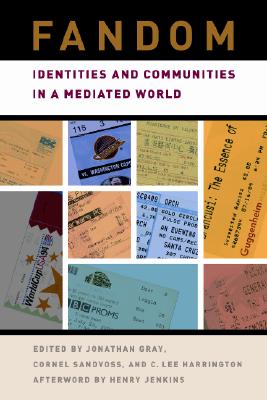In Fandom: Identities and Communities in a Mediated World, Jonathan Gray, Cornel Sandvoss, and C. Lee Harrington have edited a collection of essays that explore how fans make use of their chosen texts and justify why this exploration is valuable.
The editors give a brief overview of “fan scholarship”. Its first iteration took inspiration from de Certeau’s notion of bricolage, where fans make use of mass-mediated narratives in subversive ways. John Fiske and Henry Jenkins describe how fandom was “a collective strategy, a communal effort to form interpretive communities that in their subcultural cohesion evaded the preferred and intended meanings of the power bloc”.
Public recognition and understanding of fandom has profoundly changed over the past several decades. Moving from broadcasting to narrowcasting, fans are no longer ridiculed but courted as advertisers and producers compete for their dollars and eyes. People now communicate (their identities, worldviews, etc.) through their fandoms.
The second wave of work on fan audiences focused on the replication of social and cultural hierarchies with fan subcultures. Rather than see fandom as a means for empowerment, the taste hierarchies among the fans themselves emulate the wider social inequalities. Fans essentially maintain social and cultural systems of classification. “Blackberries, iPods, PSPs, laptops, PDAs, and cell phones all bring fan objects out with their users to the subway, the street, and even the classroom. These changing communication technologies and media texts contribute to and reflect the increasing entrenchment of fan consumption in the structure of our everyday life.”
The third wave of fan studies offers new answers to the question of what they are for. Fandom itself is not an object of study, but part of the fabric of our everyday lives, and can provide insights into our daily existence. The study of fans can help us understand how we relate to others, meet challenges, identify our place in the world, and how we read the mediated texts that facilitate all of the above.
This third wave is broken into six themes: emphasis on the symbolic and representations that mark contemporary mediated worlds, the dissolution of boundaries between different textual forms (high & pop culture), changing relationship between physical and virtual space, interplay between global and local in globalization, new identities arising out of the transformation of production and consumption in light of social and technological change, and the formation of conflict in mediated discourses (fan-tagonism).
Cornel Sandvoss notes that synthesizing fan studies with reception aesthetics enables us to explore aesthetics, a field sometimes ignored by critics, as a subjective category with objective criteria. Matt Hills advocates the generalized hybridity of contemporary media academics (academics who are also fans of what they write about) as helpful in avoiding the fallacy that scholars are objective, bias-free bringers of free thought. Rebecca Tushnet discusses the difficult notion of copyright law within the transformative fair-use doctrine. Technology gives fans greater creative control and re-mix capabilities, and there can be semiotic dissonance between what an author (profession or amateur) intends to produce and what others think the author has produced. Alan McKee argues that fans of theory are no different than fans of other cultural phenomena. Similar to Hills’ contention, he advocates fan studies as a way of opening up the methodologies of analysis. We all bring something to the table (as a “fan” of some bias, approach, ideology, perspective, text, or trend) and fan studies bring this out into the open. There are quite a few other essays here, but these are the ones that interested me. Henry Jenkins also does the epilogue and sums up the increasing salience of fan culture.
Gray, J., Sandvoss, C., & Harrington, C. L. (2007). Fandom: Identities and communities in a mediated world. New York: New York University Press.

